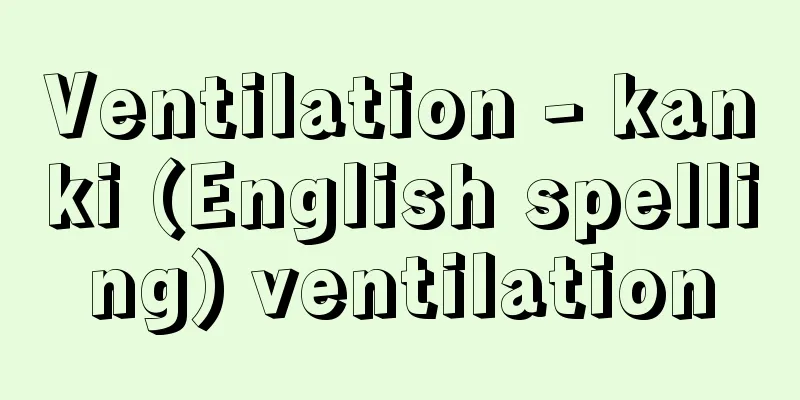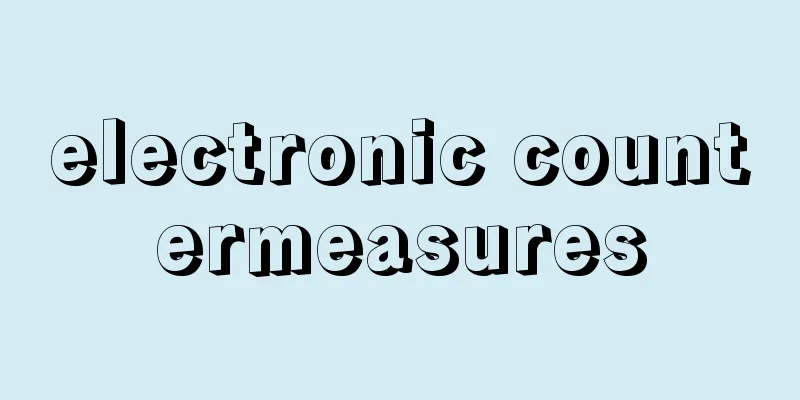Ventilation - kanki (English spelling) ventilation

|
The exchange of polluted indoor air with fresh outdoor air. Ventilation includes process ventilation, which is used for product quality control, but the most important ventilation is that which meets the needs of human health and hygiene and thermal environment regulation, and is called human ventilation. The purpose of ventilation is to expel harmful substances such as dust, harmful gases, and bacteria, unpleasant substances such as odors and smoke, and air polluted by heat and water vapor generated indoors, and to introduce fresh outside air to supply humans with the oxygen they need, while also maintaining the temperature, humidity, and airflow of the living space at appropriate levels to create a comfortable thermal environment. To achieve this goal, a minimum amount of ventilation is required so that the indoor air does not exceed a certain level of pollution, and this ventilation volume is generally called the required ventilation volume. Outside air is usually considered clean, but in areas with severe air pollution, it is not always so clean, so outside air is sometimes purified before being introduced indoors. [Masayuki Mizuhata] Indoor ventilationIn general residential environments where there is no generation of specific pollutants, carbon dioxide gas is used as an indicator of indoor air pollution. This is not because carbon dioxide gas is harmful to the human body, but because it is believed that the heat of the human body, the deterioration of the thermal environment due to the generation of water vapor, and pollution due to odors, dust, and bacteria increase with an increase in the concentration of carbon dioxide gas indoors. Smoking indoors causes a significant increase in the concentration of odors and dust particles in the air, and increases the amount of ventilation required. In order to keep indoor air at an unpleasant odor level, it is said that a smoker needs to ventilate at about 15 cubic meters per hour per cigarette, and a non-smoker needs to ventilate at twice that amount. It is also said that most of the indoor dust generated by smoking is due to cigarette smoke. In stoves, burners and other combustion appliances, incomplete combustion becomes more prevalent as the oxygen concentration in the air supplied decreases, and when the oxygen concentration falls below 19% by volume, the rate of carbon monoxide generation, which is harmful to the human body, rises sharply, so particular attention must be paid to ventilation when using open appliances indoors. The atmosphere contains about 21% oxygen, but when the oxygen concentration falls to less than 18% in a poorly ventilated room, this is called an oxygen deficiency state, which can occur in special environments such as agricultural product storage facilities and mines. The illness symptoms caused by this are called oxygen deficiency syndrome, which is essentially different from carbon monoxide poisoning. [Masayuki Mizuhata] Ventilation in the work environmentIn the work environment, there is a possibility of contamination due to the generation of various gases, and if the concentration exceeds a certain limit, it will cause health problems. This limit is called the permissible concentration. The permissible concentration of each gas for workers has been established by the Japan Society for Occupational Health. The permissible concentration is the time-average concentration that has almost no harmful effect on health when a normal, healthy adult works moderately for up to 8 hours a day. Therefore, it is not appropriate to use this as the permissible concentration in general living environments, and it is recommended that in general environments, the permissible concentration should be about 1/10 to 1/100 of the permissible concentration in the work environment. [Masayuki Mizuhata] Required ventilation volumeAccording to Article 129-2-2 of the Enforcement Order of the Building Standards Act, in order to ensure a hygienic indoor environment when a centrally controlled air conditioning system is installed, the air must be purified and supplied so that the daily average levels are below 1,000 ppm for carbon dioxide, 10 ppm for carbon monoxide, 0.15 milligrams per cubic meter for dust, and 0.5 meters per second for airflow, with a temperature between 17°C and 28°C, and a relative humidity between 40% and 70%. When only one pollutant is generated in a room, the required ventilation rate is determined based only on its permissible concentration. However, when two or more pollutants are generated and act independently, the maximum of the required ventilation rates shall be the required ventilation rate for that room. When they act in a complex manner, the total of the required ventilation rates shall be the required ventilation rate for that room. In Japan, the required ventilation volume is set out in the Building Standards Act and the ventilation standards of the Society of Heating, Air-Conditioning and Sanitary Engineers of Japan. According to the Building Standards Act, the required ventilation volume for a general room is set out as 30 cubic meters per hour or more per person in the case of a centrally controlled air-conditioning system, calculated from the carbon dioxide allowable concentration set out in Article 129, paragraph 2 of the Enforcement Order of the Act, and 20 cubic meters or more per person in the case of a mechanical ventilation system other than a centrally controlled system. However, in the case of a natural ventilation system, it is only stipulated that an opening effective for ventilation of at least 1/20 of the floor area of the room must be provided, or in the case of a room where the only opening available is less than this area, an intake and exhaust vent with an area equal to or greater than the minimum effective area set out in the same Article is provided, and there is no restriction on the required ventilation volume. In addition, the Building Standards Act also provides detailed regulations for special buildings and rooms with combustion appliances. [Masayuki Mizuhata] Natural and mechanical ventilationVentilation of a room occurs through an opening in the surrounding wall if there is a pressure difference between the inside and outside of the opening. Ventilation methods are classified into natural ventilation, which uses natural forces as the driving force for air flow, and mechanical ventilation, which uses mechanical power. Natural ventilation can be divided into gravity ventilation, which utilizes the difference in air density due to the temperature difference between indoors and outdoors, and wind ventilation, which utilizes wind pressure. The buoyancy caused by density differences is generally smaller than wind pressure, and its fluctuations are also relatively small, so gravity ventilation is smaller than wind ventilation and its fluctuations are also small. However, in the stairwells of high-rise buildings, there is a chimney effect, so gravity ventilation cannot be ignored. Natural ventilation has the advantage of not requiring power because it relies on natural forces, but it cannot maintain a constant ventilation volume. Mechanical ventilation provides a nearly constant ventilation volume and the volume can be freely selected, making it suitable for large-scale ventilation in large buildings, underground shopping malls, etc. When mechanical ventilation is performed, natural forces also act at the same time, but these are relatively small compared to the mechanical forces, so fluctuations in the ventilation volume are small. [Masayuki Mizuhata] Ventilation methodAccording to the ventilation standards of the Society of Heating, Air-Conditioning and Sanitary Engineers of Japan, ventilation methods are classified into four types. Type 1 is mechanical ventilation and is suitable for ventilating any room, type 2 is mechanical ventilation and natural exhaust and is suitable for clean rooms, and type 3 is natural ventilation and mechanical exhaust and is suitable for polluted rooms. While the above three types allow for a constant ventilation volume to be obtained at will, type 4 is a natural ventilation method that uses auxiliary ventilation devices such as a ventilation pipe, roof ventilator, or monitor roof for exhaust, and the ventilation volume is variable. In cases where conditioned air is supplied to a room away from an air conditioner, a pipe used to guide air is generally called a duct. In addition, the devices and machinery required for ventilation, such as fans and ducts, are collectively called ventilation equipment. When a pollution source such as heat, dust, or gas is fixed indoors, local ventilation is a ventilation method that uses a hood or other device above the source to capture and eliminate the pollutants as close to the source as possible. However, when it is difficult to completely eliminate the pollutants through local ventilation or when the pollution source moves, the pollutants will spread over a wide area, so the entire room must be ventilated. This method is called general ventilation, and is usually used in conjunction with local ventilation. In high-heat factories where heat is the main source of pollution, such as steel mills and foundries, local exhaust is achieved by connecting a hood installed above the source directly to a roof ventilator, and general exhaust is performed through a monitor roof installed on the factory roof to prevent the temperature in the working environment from rising, block radiant heat from the heat source, and protect workers from thermal contamination. [Masayuki Mizuhata] [Reference item] |Source: Shogakukan Encyclopedia Nipponica About Encyclopedia Nipponica Information | Legend |
|
室内の汚染空気を新鮮な外気と交換すること。換気には、製品の品質管理のために行われるプロセス・ベンチレーションという換気も含まれるが、重要なのは人間の保健衛生および熱環境調整上の必要性を満足するための換気で、これをヒューマン・ベンチレーションという。 換気の目的は、粉塵(ふんじん)、有害ガス、細菌などの有害物質や、臭気、煙などの不快物質、および室内で発生する熱、水蒸気によって汚染された空気を排出し、新鮮外気を導入して人間に必要な酸素を供給するとともに、居住空間の温湿度、気流を適度に保って快適な熱環境を形成することである。この目的を達成するには、室内空気がある汚染度以上にならないように最小限の換気をする必要があり、この換気量を一般に必要換気量という。外気は通常、清浄と考えられているが、大気汚染の著しい地域ではかならずしも清浄であるとは限らないので、外気を浄化してから室内に導入することも行われる。 [水畑雅行] 室内換気ある特定の汚染物の発生のない一般の居住環境においては、室内空気汚染の指標として炭酸ガスが用いられる。これは、炭酸ガスが人体に有害であるからではなく、人体の熱、水蒸気の発生による熱環境の悪化、および臭気、粉塵、細菌による汚染は、室内の炭酸ガス濃度の増加とともに増大すると考えられるからである。 室内で喫煙すれば、とくに空気の臭気、粉塵などの濃度の増加が著しくなり、必要換気量が増大する。室内空気を不快でない程度の臭気強度以下に保つためには、たばこ1本当り、喫煙者に対しては約15立方メートル毎時、非喫煙者に対してはその2倍の換気が必要といわれる。また、喫煙時の室内粉塵発生量の大部分はたばこの煙によるといわれる。 ストーブやこんろなどの燃焼器具は、供給される空気中の酸素濃度の減少とともに不完全燃焼が盛んになり、酸素濃度が19体積%以下になると、人体に有害な一酸化炭素の発生率が急激に高くなるので、開放型の器具を室内で使用する場合は、とくに換気に注意を払わねばならない。大気には約21%の酸素が含まれているが、換気不良の室内で18%未満になった状態を酸素欠乏状態といい、農産物の貯蔵庫、坑内などの特殊環境でこの状態が発生することがある。これによる疾病症状を酸素欠乏症といい、一酸化炭素中毒症とは本質的に異なる。 [水畑雅行] 作業環境における換気作業環境においては種々のガス発生による汚染の可能性があり、その濃度がある限界値以上になると健康障害をおこす。この限界値を許容濃度という。作業者を対象とする個々のガスの許容濃度が日本産業衛生学会によって定められている。許容濃度は、正常で健康な成人が1日8時間以内の中程度の労働を行うときに、健康に有害な影響をほとんど及ぼさない程度の時間平均濃度である。したがって、これを一般の生活環境での許容濃度として用いるのは適当ではなく、一般環境では、作業環境における許容濃度の10分の1から100分の1程度とすることが推奨されている。 [水畑雅行] 必要換気量建築基準法施行令第129条の2の2によれば、中央管理方式の空調設備を設けた場合の室内の衛生的環境を確保するためには、1日平均値で、炭酸ガスは1000ppm、一酸化炭素は10ppm、粉塵は0.15ミリグラム毎立方メートル、気流は0.5メートル毎秒、のそれぞれの値以下、温度は17℃以上28℃以下、相対湿度は40%以上70%以下の基準におおむね適合するように空気を浄化して供給することが要求されている。 必要換気量は、室内で発生する汚染物質が1種の場合には、その許容濃度のみに基づいて定められるが、2種以上の発生があり、それらが独立に汚染作用をする場合には、各必要換気量のうちの最大値をその室の必要換気量とし、複合的に作用する場合には、各必要換気量の合計をその室の必要換気量とする。 必要換気量に関するわが国の規定は、建築基準法および空気調和衛生工学会換気規格などに定められている。建築基準法によれば、一般居室の必要換気量は、中央管理方式の空調設備を有する場合には、同法施行令第129条2項に定められる炭酸ガス許容濃度からの換算によって、在室者1人当り30立方メートル毎時以上、中央管理方式以外の機械換気設備を有する場合には、在室者1人当り20立方メートル以上と定められているが、自然換気設備の場合には、居室の床面積の20分の1以上の換気に有効な開口部を設けるか、この面積未満の開口しか得られない居室では、同条同項で定める最小有効面積以上の面積をもつ給・排気口を設けることが規定されているだけで、必要換気量の制限はない。また、特殊建築物や燃焼器具を設置した居室についても建築基準法に詳細に規定されている。 [水畑雅行] 自然換気と機械換気室の換気は、周壁にある開口の内外に圧力差があれば、その開口を通じて行われる。換気方法は、空気流の駆動力として自然力を用いる自然換気と、機械力を用いる機械換気に分類される。 自然換気は、室内外温度差に基づく空気の密度差を利用する重力換気と、風圧力を利用する風力換気とに分けられる。密度差による浮力は風圧力に比べて一般に小さく、変動も比較的小さいから、重力換気量は風力換気量に比べて小さく、変動も小さい。しかし、高層建築の階段室においては煙突効果があるので、重力換気量は無視できない。自然換気は自然力に依存しているため、動力を必要としない利点はあるが、一定の換気量を維持できない。 機械換気は、ほぼ一定の換気量が得られ、換気量も自由に選びうるので、大規模な建築や地下街などの大量の換気に適している。機械換気を行う場合、同時に自然力も作用するが、それは機械力に比べて比較的小さいので、換気量の変動は小さい。 [水畑雅行] 換気方式空気調和衛生工学会換気規格によれば換気方式は4種に分類される。第1種は機械による給排気で、あらゆる室の換気に適し、第2種は機械給気・自然排気で清浄室に適し、第3種は自然給気・機械排気で汚染室に適当である。以上の3種では、任意で一定の換気量が得られるのに対して、第4種は排気に換気筒、ルーフベンチレーター、モニタールーフなどの補助換気装置を用いた自然換気方式で、換気量は不定である。 空気調和機から離れた室に調整空気を供給する場合のように、一般に空気を導くための管をダクトとよぶ。また、送風機やダクトなどの換気のために必要な装置、機械器具を換気設備と総称する。 室内において、熱、粉塵、ガスなどの汚染源が固定している場合に、発生源の上部にフードなどを設けて汚染物をできるだけその近傍で捕集して排除するための換気方法を局所換気という。しかし、汚染物を局所換気によって完全に排除することが困難な場合や、汚染源が移動するような場合には、汚染物が広範囲に拡散されるため、室全体の換気をしなければならない。この方法を全般換気といい、通常、局所換気と併用される。 製鉄工場や鋳物工場に代表されるような、熱が主たる汚染源となる高熱工場では、発生源の上部に設けたフードをルーフベンチレーターに直結して局所排気を行うとともに、工場の屋根に設けたモニタールーフを通じて全般排気を行って作業環境温度の上昇を抑制し、熱源からの放射熱を遮蔽(しゃへい)して、作業者を熱汚染から防護すべく考慮される。 [水畑雅行] [参照項目] |出典 小学館 日本大百科全書(ニッポニカ)日本大百科全書(ニッポニカ)について 情報 | 凡例 |
Recommend
Fuat Koprulu (English spelling)
…Turks who fled from Central Asia, such as Akçula...
Isooizu (English name) Pontodrilus matsushimensis
A marine earthworm in the phylum Annelida, class O...
Christmas carol
A general term for religious folk songs sung durin...
Bladder cancer
It is the most common cancer occurring in the urin...
Inugami Prefecture
…In July 1871, the feudal domains were abolished ...
Gosei - Kyosei
…It was established as an organization that carri...
Abhirati
…A transliteration of the Sanskrit Akṣobhya (mean...
Trichoplusia intermixta (English spelling)
…There are many species in temperate zones, some ...
series integral (English spelling)
...A compositional technique that was widely used...
Morita Shiken
A Meiji-era newspaper journalist and translator. ...
Large caterpillar - Large caterpillar
...Also known as the giant gnat. A marsupial mamm...
Kidney transplantation
Transplanting a kidney from another person into a ...
Kirino
Philippine politician. Leader of the Liberalist Pa...
Zhang Shì zhi (English spelling)
Chinese official of the Western Han Dynasty. Date ...
Pension Sliding System - Nenkin Sliding System
The automatic revision of pension amounts in line ...









